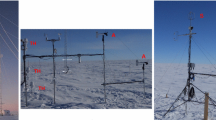Abstract
Several numerical experiments have been undertaken with a three-dimensional mesoscale model in order to determine to what extent a water surface such as a lake can influence mesoscale flow patterns.
It is shown that the influence of the lake is important when cumulus clouds are present. These clouds, generated by evaporation from the water surface are small but induce significant secondary circulations which disrupt the flow field on the mesoscale.
Artificial suppression of cloud activity results in a situation where the lake exerts little influence on the atmospheric environment in comparison to the control experiment where the body of water is absent. Atmospheric stability controls the intensity of perturbations to the mean flow when clouds are present.
The study is of interest when modeling a number of complex phenomena simultaneously; the results shown here indicate that under certain stability conditions, a small lake can be ignored as to its dynamic and thermodynamic influence on atmospheric processes, thus leading to a neglect of a number of equations taking into account moisture terms explicitly.
Similar content being viewed by others
References
Augstein, E. and Wendel, M.: 1981, ‘Modelling of the Time-Dependent Atmospheric Tradewind Boundary Layer with Non-Precipitating Cumulus Clouds’, Contr. Atm. Phys. 53, 509–538.
Beniston, M.: 1982, ‘Développement d'un modéle tridimensionnel \' meso-échelle pour l'étude de la convection cellulaire, La Météorologie 29, 193–200.
Beniston, M.: 1983, ‘Meso-scale Model for the Investigation of Three-Dimensional Convective Phenomena. Model Description and Preliminary Results from a KonTur Simulation’, Hamb. Geophys. Einzel. B2, 1–62.
Beniston, M.: 1984, ‘A Numerical Study of Atmospheric Mesoscale Cellular Convection’, Dyn. Atm. Oc. 8, 223–242.
Beniston, M.: 1985, ‘Organisation of Convection in a Numerical Mesoscale Model as a Function of Initial and Lower Boundary Conditions’, Contr. Atm. Phys. 58, 31–52.
Beniston, M. and Schmetz, J.: 1985, ‘A Three-Dimensional Study of Mesoscale Model Response to Radiative Forcing’, Boundary-Layer Meterol. 31, 149–175.
Bradley, E. F.: 1968, ‘A Micrometeorological Study of Velocity Profiles and Surface Drag in the Region Modified by a Change of Roughness’, Quart. J. Roy. Meteorol. Soc. 94, 361–379.
Businger, J.-A., Wyngaard, J.-C., Izumi, Y., and Bradley, E. F.: 1971, ‘Flux-Profile Relationships in the Atmospheric Surface Layer’, J. Atmos. Sci. 28, 181–189.
Estoque, M. A.: 1961, ‘A Theoretical Investigation of the Sea Breeze’, Quart. J. Roy. Meteorol. Soc. 87, 136–146.
Kessler, E.: 1969, ‘On the Distribution and the Continuity of Water Substance in Atmospheric Circulations’, Meterol. Monogr., Am. Meteorol. Soc. 32, 84 pp.
O'Brien, J. J.: 1970, ‘A Note on The Vertical Structure of the Eddy Exchange Coefficient in the Planetary Boundary Layer’, J. Atmos. Sci. 27, 1213–1215.
Perkey, D. J. and Kreizberg, C. W.: 1976, ‘A Time-Dependent Lateral Boundary Scheme for Limited Area Primitive Equation Models’, Mon. Wea. Rev. 104, 744–755.
Peterson, E. W.: 1969, ‘Modification of Mean Flow and Turbulent Energy by a Change in Surface Roughness Under Conditions of Neutral Stability’, Quart. J. Roy. Meteorol. Soc. 95, 561–575.
Pielke, R. A.: 1974, ‘A Three-Dimensional Numerical Model of the Sea Breezes over South Florida’, Mon. Wea. Rev. 102, 115–139.
Schmelz, J. and Beniston, M.: 1986, ‘Relative Effects of Solar and Infrared Radiative Forcing in a Mesoscale Model’, Boundary-Layer Meteorol. 34, 337–353.
Taylor, P. A.: 1970, ‘A Model of Air Flow Above Changes in Surface Heat Flux, Temperature, and Roughness for Neutral and Unstable Conditions’, Boundary-Layer Meteorol. 1, 18–39.
Townsend, A. A.: 1965, ‘The Flow in a Turbulent Boundary Layer After a Change in Surface Roughness’, J. Fluid Mech. 26, 255–266.
Author information
Authors and Affiliations
Rights and permissions
About this article
Cite this article
Beniston, M. The influence of a water surface on mesoscale dynamics as a function of atmospheric stability. Boundary-Layer Meteorol 36, 19–37 (1986). https://doi.org/10.1007/BF00117456
Accepted:
Issue Date:
DOI: https://doi.org/10.1007/BF00117456




